Project Background:
The plant leaf recognition using deep learning stems from the intersection of computer vision and botany, aiming to automate and improve the accuracy of plant species identification based on leaf characteristics. Traditional plant identification methods rely on manual observation and expert knowledge, which can be time-consuming, subjective, and prone to human error. With the advancements in deep learning techniques and the availability of large-scale image datasets, it has become feasible to develop automated systems capable of recognizing plant species based on leaf images. Deep learning models, particularly convolutional neural networks (CNNs), excel at learning intricate patterns and features directly from image data, enabling the accurate classification of plant leaves.
By training deep neural networks on annotated datasets of leaf images, these models can learn to distinguish between different plant species based on their unique leaf shapes, textures, colors, and vein patterns. Moreover, deep learning-based plant leaf recognition systems offer the flexibility to adapt to variations in leaf morphology and environmental conditions, making them valuable tools for botanical research, agriculture, environmental monitoring, and biodiversity conservation. Thus, the project work in plant leaf recognition using deep learning represents a convergence of cutting-edge technology and botanical science with the potential to revolutionize plant identification and contribute to understanding and conserving plant diversity.
Problem Statement
- The vast diversity in leaf shapes, sizes, textures, and colors poses a challenge for accurate and robust recognition using traditional methods.
- Manual methods of plant leaf recognition are labor-intensive and time-consuming, limiting their scalability to large-scale datasets and real-time applications.
- Human-based identification methods may suffer from subjectivity and inconsistency, leading to inaccurate plant species classification and misidentification.
- Changes in lighting conditions, background clutter, and occlusions can affect the appearance of leaf images, complicating the recognition process.
- Acquiring large-scale labeled datasets of plant leaf images for training deep-learning models can be challenging and may require substantial effort and expertise.
Aim and Objectives
- Develop an automated plant leaf recognition system using deep learning techniques to identify plant species based on leaf images accurately.
- Enhance the accuracy and robustness of the plant leaf recognition system by exploring advanced deep-learning architectures and optimization techniques.
- Develop methods to handle variability in leaf characteristics, such as shape, texture, color, and vein patterns, to improve the generalization ability of the models.
- Validate the performance of the plant leaf recognition system through rigorous evaluation on diverse datasets and real-world scenarios, ensuring high accuracy and reliability.
- Deploy the automated plant leaf recognition system for practical applications in botanical research, agriculture, environmental monitoring, and biodiversity conservation.
Contributions to Plant Leaf Recognition using Deep Learning
- Deep learning-based plant leaf recognition systems automate identifying plant species from leaf images, reducing the reliance on manual observation and expert knowledge.
- Accuracy and Robustness of plant leaf recognition by effectively learning discriminative features from large-scale datasets, leading to more reliable identification results.
- The automated nature of deep learning-based plant leaf recognition systems allows for scalability to large-scale datasets and real-time applications, enabling efficient processing of large volumes of leaf images.
- Generalization approaches handle variability in leaf characteristics, such as shape, texture, and color, enabling the recognition of diverse plant species across different environmental conditions and leaf morphologies.
- Contributes to various practical applications in botanical research, agriculture, environmental monitoring, and biodiversity conservation, facilitating plant species identification and classification tasks.
Deep Learning Algorithms for Plant Leaf Recognition
- Convolutional Neural Networks (CNNs)
-
Transfer Learning with Pre-trained CNNs
-
Residual Networks (ResNet)
-
Inception Networks
-
Dense Convolutional Networks (DenseNet)
-
Capsule Networks
-
Siamese Networks
-
Recurrent Neural Networks (RNNs)
-
Attention Mechanisms
-
Graph Neural Networks (GNNs)
Datasets for Plant Leaf Recognition using Deep Learning
- Flavia Dataset
-
Foliage Dataset
-
Leafsnap Dataset
-
PlantCLEF Dataset
-
Swedish Leaf Dataset
-
Brazilian Flora Dataset
-
Iris Plants Dataset
-
Oxford Flowers Dataset
-
Tariq Dataset
-
Vistex Dataset
Software Tools and Technologies:
Operating System: Ubuntu 18.04 LTS 64bit / Windows 10
Development Tools: Anaconda3, Spyder 5.0, Jupyter Notebook
Language Version: Python 3.9
Python Libraries:
1. Python ML Libraries:
- Scikit-Learn
- Numpy
- Pandas
- Matplotlib
- Seaborn
- Docker
- MLflow
2. Deep Learning Frameworks:
- Keras
- TensorFlow
- PyTorch
